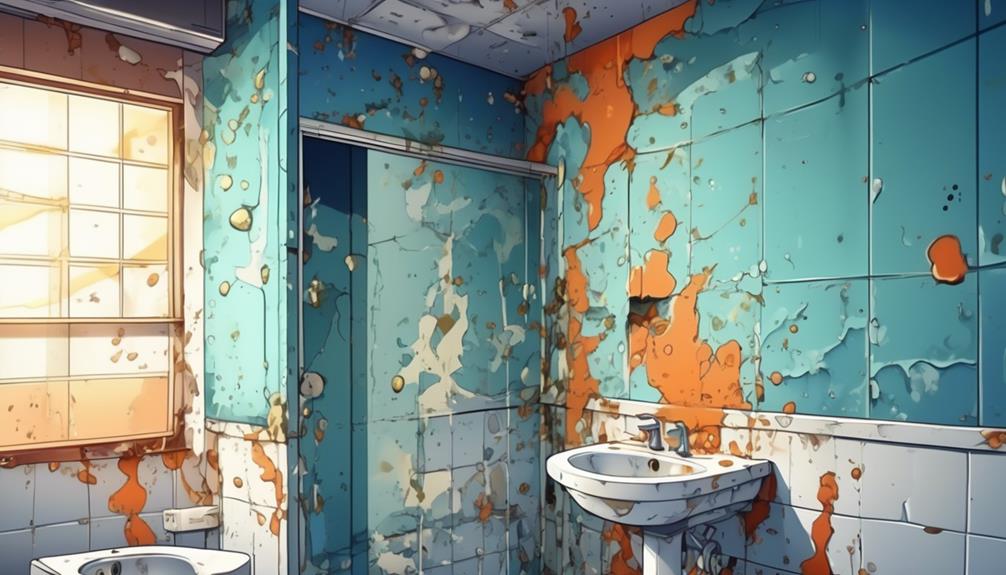Stepping into the shower and noticing a water stain on the wall can be concerning. The likely cause is water seepage from the shower, leading to damage on the wall.
To address this issue, consider resealing the edges of the shower, fixing any leaks, and ensuring proper ventilation to prevent future damage.
A quick solution is to inspect the shower area for any visible cracks or gaps and reseal them using waterproof sealant. This can help stop water from seeping into the wall and prevent further damage.
Understanding the Causes

Water damage next to your shower can be caused by several factors.
A cracked or damaged shower pan can allow water to seep through and accumulate behind the walls, leading to water damage.
Worn-out or improperly installed shower doors or curtains with a worn sealant or improper closure can also cause water to escape and damage adjacent walls.
Leaking showerheads or faucets can contribute to water damage, even from small drips over time.
Poor ventilation in the bathroom can lead to moisture buildup, mold growth, and water damage.
Lastly, insufficient waterproofing during the construction of the shower area can also cause water damage.
It's important to address these causes to prevent water damage next to your shower.
Assessing the Damage
To assess the damage caused by water next to your shower, carefully inspect the affected area for visible signs of moisture and structural deterioration. Start by examining the wall adjacent to the shower. Look for water stains, discoloration, or peeling paint as these can indicate water penetration. Check the baseboards and flooring for any warping or swelling, as this may suggest prolonged exposure to moisture. Additionally, inspect the caulking and grout lines around the shower to see if they are cracked or missing, as this could be a potential source of water leakage.
To help you better understand the signs of water damage, refer to the table below:
| Signs of Water Damage | Possible Causes | Action Required |
|---|---|---|
| Water stains on the wall | Leaking shower or pipes | Fix the source of the leak |
| Discoloration or peeling paint | Moisture penetration | Repair and repaint the wall |
| Warping or swelling of baseboards or flooring | Prolonged exposure to water | Replace damaged materials |
| Cracked or missing caulking or grout lines | Water leakage | Reapply caulking or regrout |
Repairing the Water Damage

To repair the water damage, first find and fix the leak.
Then follow these steps:
- Remove damaged drywall: Use a utility knife to cut away the damaged areas.
- Dry out the area: Use a dehumidifier and fans to remove moisture.
- Repair the drywall: Replace damaged sections with new pieces, secure them with drywall screws, and apply joint compound.
- Prime and paint: Apply primer and paint to match the rest of the bathroom.
- Seal the area: Apply waterproof sealant around the shower to prevent future damage.
Preventing Future Issues
To prevent future water damage next to your shower, regularly check for leaks and moisture. Catching the problem early can save you from costly repairs and potential health hazards. Here are some simple steps you can take to keep your bathroom dry and damage-free:
| Step | Action | Frequency |
|---|---|---|
| 1 | Check for Leaks | Monthly |
| 2 | Clean Shower Drain | Weekly |
| 3 | Seal Grout and Caulking | Annually |
| 4 | Use a Shower Curtain Liner | Always |
| 5 | Install a Shower Splash Guard | As needed |
Inspect the walls and floors around your shower regularly for any signs of leaks, such as discoloration or peeling paint. Clean your shower drain weekly to prevent clogs and backups. Annually, seal the grout and caulking to maintain their integrity and prevent water seepage. Always use a shower curtain liner to create an extra barrier against water splashes. Additionally, consider installing a shower splash guard for added protection.
